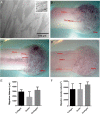Development and application of a 3D periodontal in vitro model for the evaluation of fibrillar biomaterials
- PMID: 32429904
- PMCID: PMC7238548
- DOI: 10.1186/s12903-020-01124-4
Development and application of a 3D periodontal in vitro model for the evaluation of fibrillar biomaterials
Abstract
Background: Periodontitis is a chronic inflammation of the tooth supporting structures that finally can lead to tooth loss. As chronic periodontitis is associated with systemic diseases multiple approaches have been followed to support regeneration of the destructed tissue. But very few materials are actually used in the clinic. A new and promising group of biomaterials with advantageous biomechanical properties that have the ability to support periodontal regeneration are self-assembling peptides (SAP). However, there is still a lack of 3D periodontal models that can evaluate the migration potential of such novel materials.
Methods: All experiments were performed with primary human periodontal ligament fibroblasts (HPLF). Migration capacity was assessed in a three-dimensional model of the human periodontal ligament by measuring the migration distance of viable cells on coated (Enamel Matrix Protein (EMP), P11-4, collagen I) or uncoated human dentin. Cellular metabolic activity on P11-4 hydrogels was assessed by a metabolic activity assay. Deposition of ECM molecules in a P11-4 hydrogel was visualized by immunostaining of collagen I and III and fibrillin I.
Results: The 3D periodontal model was feasible to show the positive effect of EMP for periodontal regeneration. Subsequently, self-assembling peptide P11-4 was used to evaluate its capacity to support regenerative processes in the 3D periodontal model. HPLF coverage of the dentin surface coated with P11-4 increased significantly over time, even though delayed compared to EMP. Cell viability increased and inclusion of ECM proteins into the biomaterial was shown.
Conclusion: The presented results indicate that the 3D periodontal model is feasible to assess periodontal defect coverage and that P11-4 serves as an efficient supporter of regenerative processes in the periodontal ligament.
Clinical relevance: The establishment of building-block synthetic polymers offers new opportunities for clinical application in dentistry. Self-assembling peptides represent a new generation of biomaterials as they are able to respond dynamically to the changing environment of the biological surrounding. Especially in the context of peri-implant disease prevention and treatment they enable the implementation of new concepts.
Keywords: 3D model; Periodontal ligament; Regeneration; Self-assembling peptide.
Conflict of interest statement
All authors declare no competing interests.
Figures







Similar articles
-
Biomimetic collagen-sodium alginate-titanium oxide (TiO2) 3D matrix supports differentiated periodontal ligament fibroblasts growth for periodontal tissue regeneration.Int J Biol Macromol. 2020 Nov 15;163:9-18. doi: 10.1016/j.ijbiomac.2020.06.173. Epub 2020 Jun 20. Int J Biol Macromol. 2020. PMID: 32569686
-
Tailored Biomaterials for Therapeutic Strategies Applied in Periodontal Tissue Engineering.Stem Cells Dev. 2019 Aug 1;28(15):963-973. doi: 10.1089/scd.2019.0016. Epub 2019 May 24. Stem Cells Dev. 2019. PMID: 31020906 Review.
-
Concise Review: Periodontal Tissue Regeneration Using Stem Cells: Strategies and Translational Considerations.Stem Cells Transl Med. 2019 Apr;8(4):392-403. doi: 10.1002/sctm.18-0181. Epub 2018 Dec 26. Stem Cells Transl Med. 2019. PMID: 30585445 Free PMC article. Review.
-
Challenges and Tissue Engineering Strategies of Periodontal-Guided Tissue Regeneration.Tissue Eng Part C Methods. 2022 Aug;28(8):405-419. doi: 10.1089/ten.TEC.2022.0106. Tissue Eng Part C Methods. 2022. PMID: 35838120 Review.
-
Amino acid composition of nanofibrillar self-assembling peptide hydrogels affects responses of periodontal tissue cells in vitro.Int J Nanomedicine. 2018 Oct 23;13:6717-6733. doi: 10.2147/IJN.S173702. eCollection 2018. Int J Nanomedicine. 2018. PMID: 30425485 Free PMC article.
Cited by
-
The recent advances in scaffolds for integrated periodontal regeneration.Bioact Mater. 2021 Mar 18;6(10):3328-3342. doi: 10.1016/j.bioactmat.2021.03.012. eCollection 2021 Oct. Bioact Mater. 2021. PMID: 33817414 Free PMC article. Review.
-
Proteomic and single-cell analysis shed new light on the anti-inflammatory role of interferonβ in chronic periodontitis.Front Pharmacol. 2023 Oct 9;14:1232539. doi: 10.3389/fphar.2023.1232539. eCollection 2023. Front Pharmacol. 2023. PMID: 37876725 Free PMC article.
-
Smart injectable hydrogels for periodontal regeneration: Recent advancements in biomaterials and biofabrication strategies.Mater Today Bio. 2025 May 11;32:101855. doi: 10.1016/j.mtbio.2025.101855. eCollection 2025 Jun. Mater Today Bio. 2025. PMID: 40487163 Free PMC article. Review.
-
The Effect of Diabetes Mellitus on IGF Axis and Stem Cell Mediated Regeneration of the Periodontium.Bioengineering (Basel). 2021 Dec 3;8(12):202. doi: 10.3390/bioengineering8120202. Bioengineering (Basel). 2021. PMID: 34940355 Free PMC article. Review.
-
Current Trends in In Vitro Modeling to Mimic Cellular Crosstalk in Periodontal Tissue.Adv Healthc Mater. 2021 Jan;10(1):e2001269. doi: 10.1002/adhm.202001269. Epub 2020 Nov 16. Adv Healthc Mater. 2021. PMID: 33191670 Free PMC article. Review.
References
-
- Omar AA, et al. Associations between subgingival plaque bacterial morphotypes and clinical indices? J Clin Periodontol. 1991;18(7):555–566. - PubMed
-
- Sanchez-Perez A, Moya-Villaescusa MJ. Periodontal disease affecting tooth furcations. A review of the treatments available. Med Oral Patol Oral Cir Bucal. 2009;14(10):e554–e557. - PubMed
-
- Shi T, et al. Periodontal disease and susceptibility to breast cancer: a meta-analysis of observational studies. J Clin Periodontol. 2018. - PubMed
Publication types
MeSH terms
Substances
Grants and funding
LinkOut - more resources
Full Text Sources
Research Materials
Miscellaneous

